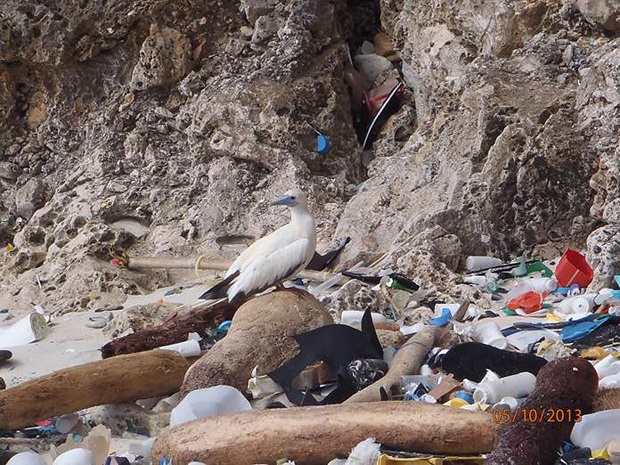What’s in 90 percent of seabirds’ guts? 1 word: Plastics

In this photo taken in 2013, provided by Britta Denise Hadety, a red-footed booby on Christmas Island, in the Indian Ocean. As many as nine out of ten of the world’s seabirds likely have pieces of plastic in their guts, a new study estimates. Previously, scientists figured about 29 percent of seabirds had swallowed plastic, but those are older studies. An Australian team of scientists who have studied birds and marine debris for decades used computer models to update those figures, calculating that far more seabirds are affected, according to a new study published in the journal Proceedings of the National Academy of Sciences Monday. AP
WASHINGTON — As many as nine out of 10 of the world’s seabirds likely have pieces of plastic in their guts, a new study estimates.
Previously, scientists figured about 29 percent of seabirds had swallowed plastic, based on older studies. An Australian team of scientists who have studied birds and marine debris for decades used computer models to update those figures, calculating that far more seabirds are affected, according to a new study published Monday in the journal Proceedings of the National Academy of Sciences.
“It’s pretty astronomical,” said study co-author Denise Hardesty, senior research scientist at the Australian federal science agency. She said the problem with plastics in the ocean is increasing as the world makes more of the stuff. “In the next 11 years we will make as much plastic as has been made since industrial plastic production began in the 1950s.”
She combined computer simulations of locations of the garbage and the birds, as well as their eating habits, to see where the worst problems are.
Hardesty’s work found that the biggest problem strangely isn’t where there’s the most garbage, such as the infamous garbage patch in the central north Pacific Ocean. Instead it’s where there’s the greatest number of different species, especially in the southern hemisphere near Australia and New Zealand.
Areas around North America and Europe are better off, she said. By reducing plastic pellets, Europe is even seeing fewer of those plastic bits in one key bird, the northern fulmar, she said. Some species of albatross and shearwaters seem to be the most prone to eating plastic pieces.
Birds mistake plastic bits for fish eggs, so “they think they’re getting a proper meal but they’re really getting a plastic meal,” Hardesty said.
Usually it’s incredibly tiny pieces of plastic, but Hardesty has seen far bigger things, such as an entire glow stick and three balloons in a single short-tailed shearwater bird.
“I have seen everything from cigarette lighters … to bottle caps to model cars. I’ve found toys,” Hardesty said.
And it’s only likely to get worse. By 2050, 99 percent of seabirds will have plastic in them, Hardesty’s computer model forecast. That prediction “seems astonishingly high, but probably not unrealistic,” said American University environmental scientist Kiho Kim, who wasn’t part of the study but praised it.